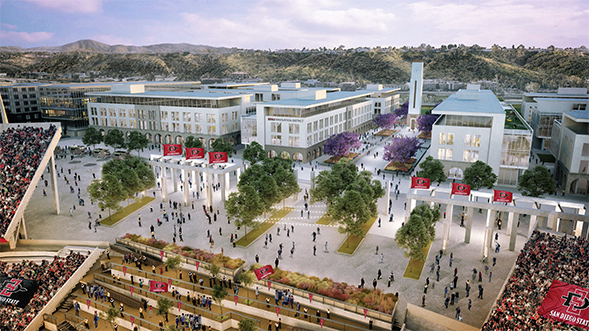SDSU Presents 'Fair and Equitable' Offer for Purchase of Stadium Site
Fair market value and other commitments equate to more than $150 million in value for the City of San Diego.

San Diego State University shared with members of the San Diego City Council and the public on Monday details of the university’s offer to purchase the Mission Valley stadium site. SDSU’s offer includes paying the City of San Diego the appraised fair market value of $68.2 million for the land, developing and maintaining a 34-acre community river park, affordable housing, a new multi-use stadium, and the construction of an independent two-lane at-grade Fenton Parkway bridge. The offer is valued at more than $150 million.
Speaking at Monday’s San Diego City Council hearing, SDSU President Adela de la Torre said SDSU looks forward to being the next steward of the vital public land.
“SDSU Mission Valley will encourage opportunities for all, providing quality higher education, building collaborative spaces to facilitate innovation, enhancing environmental sustainability and living wages,” de la Torre said. “Today, our offer not only complies with everything in Measure G, we believe it also goes above and beyond in providing tangible benefits and physical amenities for the residents of our great city.”
SDSU’s offer presented by SDSU consultant John Kratzer, CEO of JMI Realty, includes:
- A cash offer of $68.2 million for the land. This is the appraised fair market value of the 132 acres as determined by appraiser David Davis, a certified appraiser hired jointly by the City and SDSU.
- Building and maintaining — in perpetuity— a 34-acre river park at no expense to the City of San Diego or its taxpayers. This includes SDSU’s estimated river park construction price of at least $30 million, with additional maintenance costs estimated at nearly $600,000 per year. The park is designed to accept 100-year flood conditions, and to accommodate any overflow flooding from Murphy Canyon Creek. Additional park space will be constructed and maintained at an additional cost estimated at $10 million.
- Responsibility for Existing Stadium Maintenance and Capital Costs. SDSU will take over operations of the existing stadium the day escrow closes and will completely pay for the demolition of the existing stadium at a cost of $10-15 million. The City’s annual cost to maintain the stadium has been estimated anywhere between $6 million and $18 million – a burden to the City that SDSU will take over on day one.
- Construction of a two-lane at-grade Fenton Parkway bridge. SDSU in partnership with the City will take responsibility for funding and constructing the bridge following a separate environmental review. Pending the development of a reimbursement agreement or receiving credit toward the university’s development impact fees so that SDSU only funds its “fair share” of the bridge’s approximately $25 million cost.
- Affordable housing onsite. At least 10% of the housing units will be restricted as affordable housing and built on site, with no in-lieu fee option.
“This offer is the result of 10 months of negotiations with City staff and well over 100 meetings,” Kratzer said. “We have now advanced the process to the point that we can talk openly and transparently about our proposal.”
SDSU also responded to the Oct. 11 report from the City’s Independent Budget Analyst which inaccurately interprets the language in Measure G, now codified in the San Diego Municipal Code (SDMC 22.0908), and attempts to add an annual inflation factor of 6.59% to drive the value higher, despite the law requiring the date of valuation to be Sept. 30, 2017.
The appraiser clarified in a note to SDSU and the City that the inflation factor applies to the full three-year period between September 2017 and September 2020 and should not be applied annually.
“Our offer is a fair and equitable one for the City of San Diego and realizes all of the commitments SDSU has made,” de la Torre added. “At SDSU, we deliver a first-rate education for a fair price and a fair price is all we ask for in purchasing this site.”



